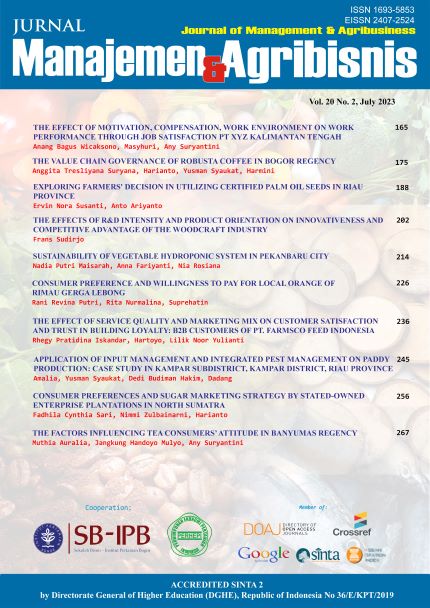Application of Input Management and Integrated Pest Management on Paddy Production: Case Study in Kampar Subdistrict, Kampar District, Riau Province
Abstract
The attack levels of plant pest organisms (PPO) highly influence the productivity of paddy rice farming. With the increasing human awareness of the dangers of using pesticides, especially for the environment and human health, PPO control prioritizes preventive control by applying the principles of integrative pest management (IPM), which prioritizes the application of healthy crop cultivation, routine observation, utilization of natural enemies and farmers as IPM experts. The use of inputs by farmers in production activities can affect the resulting production. This study aimed to estimate the effect of input management, IPM, and non-IPM on paddy rice production. The analysis used in this study was the Cobb-Douglas production function with the multiple linear regression method. Partially, each variable of land area, seeds, inorganic fertilizers, and dummy variables of IPM or non-IPM farmers significantly affected paddy rice production in Kampar Subdistrict. Variables of organic fertilizers, natural pesticides interacted with frequency, chemical pesticides interacted with frequency, and labor partially had no significant effect on lowland paddy rice production in Kampar Subdistrict. It is necessary to re-enact counseling on IPM in Kampar Subdistrict, Kampar District, to apply IPM principles that prioritize preventive PPO control to avoid the dangers of using pesticides for the environment and human welfare.
Keywords: Cobb-Douglas, plant pest organisms, integrative pest management, non-IPM, rice paddy production
Authors
Authors who publish with this journal agree to the following terms:
- Authors retain copyright and grant the journal right of first publication with the work simultaneously licensed under a Creative Commons Attribution License that allows others to share the work with an acknowledgement of the work's authorship and initial publication in this journal.
- Authors are able to enter into separate, additional contractual arrangements for the non-exclusive distribution of the journal's published version of the work (e.g., post it to an institutional repository or publish it in a book), with an acknowledgement of its initial publication in this journal.
- Authors are permitted and encouraged to post their work online (e.g., in institutional repositories or on their website) prior to and during the submission process, as it can lead to productive exchanges, as well as earlier and greater citation of published work (See The Effect of Open Access).

